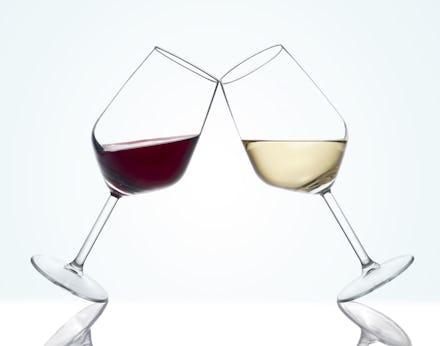You only need one type of wine glass

Real talk, I have broken every wine glass I have ever owned. Right now, when folks come over for dinner to my place, it’s all mason jars and mugs I accidentally stole from friends. I want to invest in some decent stemware, but it’s all so intimidating. I’m all for tannins and legs and other elements of wine-snobbery but does having the “right” glass for each wine really matter? Most of us have neither the space in our homes nor the patience to chase flutes versus coups. So I asked a bonafide wine pro to give me the inside scoop on how to choose a wine glass — just one, that could be used for whichever bottle you want to crack open.
“At Moet, we only have white wine glasses,” says Angela Sauve, brand educator manager at Moët Hennessy. I was floored. Moet is known for their bubbly, and I always thought you needed a slim, fancy flute for champagne. That’s a myth, apparently. “Champagne flutes are pretty for the bubbles, but a white wine glass will give you a lot of effervescence,” Sauve tells Mic. “The white wine glass pushes the aromatics to the top. Even for champagne, it will showcase the complexity of the flavor in a way that a flute will not.”
Sauve tells me that the wine glass she recommends — if you’re determined to have only one type in your home — is 2.5 inches in diameter with a stem. “The glass itself is straight up and down, more narrow than a red wine glass, wider than a flute,” she says.
The specs are crucial here because while I’ve always assumed wine wine glasses are largely about aesthetics, the real beauty behind them is pretty scientific. There’s a formula to the ideal experience. “The shape of the wine glass allows aromas to hit the glass at different points. Each flavor molecule has its own weight,” Sauve explains. “When we use special glassware, it’s to maximize the experience." But most of us, who drink wine casually, won’t be able to detect the nuances that all those different glasses may enhance. So one solid, versatile white wine glass works.
Even for those red wines that pair well with heavier meals, Sauve says, the white wine glass will work. You may need to change a little about the way you serve your reds to get the fullest experience, though. “When you’re using a white wine glass for red wine, you may have to treat it a bit differently,” she suggests. “For fuller-bodied reds, give it a swirl or decant; they need a little more air. There are living things in the bottle and they have to be woken up.” Sauve suggests decanting (pouring it into a carafe) red wine for five to 30 minutes before drinking — the more aged it is, the longer it should sit.
Another upside to adopting a white wine glass as your official chalice is that they’re not generally expensive or intimidating. “If you don’t want to spend a fortune, you can get a quality set for not much of an investment,” Sauve says. The standard Reidel white wine glass, which she uses at home, is one of her favorites.
Really, experiencing several notes and flavors is the goal when it comes to enjoying wine. “This glass pushes everything to the top,” she says. “We smell in layers, similar to the way we experience fragrance.” With a white wine glass you’ll smell the top, the heart, and the base, and even the notes lingering at the bottom — allowing you to have a full experience of what Suave calls “the beautiful orchestra of flavors in wine.”